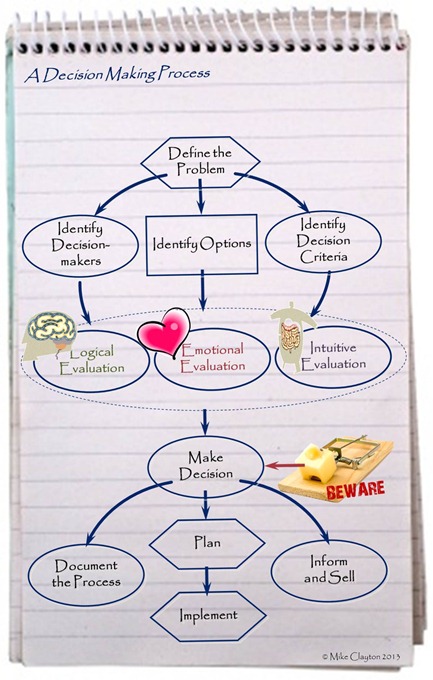Pocketblog has gone back to basics This is part of an extended course in management.
In understanding decision-making, there are three key things to focus on:
- Using a structured process
- The role of intuition, gut instinct and hunches
- The effects of bias and automatic thinking
Let’s look at each of these in turn.
Structured Decision Making Process
… like the example below.
One of the most important choices in your decision process will be whether to go for an adversarial process of setting the options against one another – perhaps even having advocates for each, competing with one another to win the decision – or to go for a process of inquiry, learning as much as you can before assessing the options.
Intuition
Although Malcolm Gladwell received a lot of attention for his book Blink, his work leans heavily on the research by Gary Klein and his books, The Power of Intuition and the more technical Sources of Power are first rate. Klein shows how, in domains that are very complex and in which you have extensive experience, your intuition can quickly get you to the right understanding, well ahead of your ability to explain why or how you reached the conclusion you did. But, if you don’t have sufficient experience, then your hunches are likely to be wrong, due to the existence of…
Bias and Automatic Thinking
Two psychologists, Daniel Kahnemann and Amos Tversky, were responsible for overthrowing the crude assumption that economics is based on rational decisions. In fact, they showed that many decisions are a result of automatic thinking and biases. The automatic thinking is a short cut that works well in the domains in which humans evolved, but leads frequently to wrong answers in a modern world context. An example is the ‘horns and halo effect’ and another is our bias towards noticing examples that confirm what we believe to be true, whilst being blind to counter examples. Daniel Kahnemann wrote the wonderful ‘Thinking, Fast and Slow’ to summarise a life’s research and it is, without a doubt, one of the most important and stimulating reads of the last few years.




